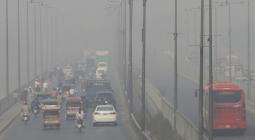Toxic air killed more than 500,000 people in EU in 2021, data shows

European Environment Agency says half of deaths could have been avoided by cutting pollution to recommended limits
Dirty air killed more than half a million people in the EU in 2021, estimates show, and about half of the deaths could have been avoided by cutting pollution to the limits recommended by doctors.
The researchers from the European Environment Agency attributed 253,000 early deaths to concentrations of fine particulates known as PM2.5 that breached the World Health Organization’s maximum guideline limits of 5µg/m3. A further 52,000 deaths came from excessive levels of nitrogen dioxide and 22,000 deaths from short-term exposure to excessive levels of ozone.
“The figures released today by the EEA remind us that air pollution is still the number one environmental health problem in the EU,” said Virginijus Sinkevičius, the EU’s environment commissioner.
Doctors say air pollution is one of the biggest killers in the world but death tolls will drop quickly if countries clean up their economies. Between 2005 and 2021, the number of deaths from PM2.5 in the EU fell 41%, and the EU aims to reach 55% by the end of the decade.
The WHO, which tightened its air quality guidelines in 2021, warns that no level of air pollution can be considered safe but has set upper limits for certain pollutants. The European parliament voted in September to align the EU’s air quality rules with the WHO’s but decided to delay doing so until 2035.
“The good news is that clean air policy works, and our air quality is improving,” said Sinkevičius. “But we need to do better still, and bring pollution levels down further.”
For the first time, the EEA estimated the full burden of disease from air pollution. As well as looking at the raw death tolls, the researchers worked out how many more years the population was living with diseases brought on by bad air.
For some health problems, such as lung cancer and ischaemic heart disease, the extra step changed little. But for others, such as asthma, it revealed high levels of suffering that had been overlooked in mortality statistics.
“When people get lung cancer, normally they die very quickly,” said Alberto González Ortiz, an EEA air pollution researcher. “For other diseases – especially asthma but also diabetes or also chronic obstructive pulmonary disease – there is also an important contribution of this state of living with disability.”
For chronic obstructive pulmonary disease brought on by PM2.5 pollution in 2021, the EEA estimated about 150,000 years of life have been lost across the EU and about the same number of years of disability.
“People can live for a long period in a bad condition,” said González Ortiz. “Considering only mortality, we were underestimating the impact of air pollution.”
Burning fossil fuels, driving cars and farming livestock release large volumes of toxic gas and harmful particles that people then breathe. The smallest of these particles, known as PM2.5, can pass into the bloodstream, where they spread through the body and damage organs from the brains down to reproductive organs.
An investigation by the Guardian this year found 98% of people in Europe were breathing air clogged with so many pollutants it breached WHO guidelines. The burden of disease, as shown in the EEA results, also falls mostly in eastern and south-eastern Europe.
Leena Ylä-Mononen, the executive director of the EEA, said: “The positive news is that authorities at European, national and local levels are taking action to reduce emissions through measures like promoting public transport or cycling in city centres, and through updated legislation.”
Photograph: Eye Ubiquitous/Alamy - Air pollution smog over Athens, Greece, in 2021.






